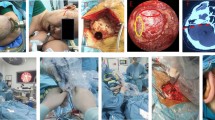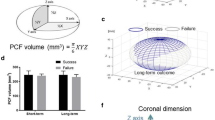Abstract
Background
Micro-vascular decompression (MVD) is a useful surgical technique in treating hemi-facial spasm (HFS). However, sensory disturbance and headache are the common postoperative complications.
Aims
This study seeked to estimate whether lesser occipital nerve (LON) preservation was conducive to reducing the incidence of adverse events.
Methods
We retrospectively compared the operation time and postoperative complications between 28 HFS patients who underwent MVD with LON preservation from January 2011 to December 2012 (LON preservation group) and 12 HFS patients who underwent MVD without preserving LON in 2010 (control group).
Results
Compared with the control group, patients in the LON preservation group showed increased operation time but reduced incidences of sensory disturbances around occipitalis (P = 0.017) and posterior auricular (P = 0.002). However, there were no significant differences in other postoperative complications such as headache (P = 0.414), incision infection (P = 0.527) or cerebrospinal fluid leakage (P = 0.527).
Conclusions
For HFS patients who attempted to receive MVD, LON preservation could reduce the incidence of sensory disturbance around the operative region, despite causing extend operation time.

Similar content being viewed by others
References
Wilkins RH (1991) Hemifacial spasm: a review. Surg Neurol 36(4):251–277
Wang A, Jankovic J (1998) Hemifacial spasm: clinical findings and treatment. Muscle Nerve 21(12):1740–1747
Neves DO, Lefaucheur JP, de Andrade DC, Hattou M, Ahdab R, Ayache SS, Le Guerinel C, Keravel Y (2009) A reappraisal of the value of lateral spread response monitoring in the treatment of hemifacial spasm by microvascular decompression. J Neurol Neurosurg Psychiatry 80(12):1375–1380. doi:10.1136/jnnp.2009.172197
Jannetta PJ, Abbasy M, Maroon JC, Ramos FM, Albin MS (1977) Etiology and definitive microsurgical treatment of hemifacial spasm. Operative techniques and results in 47 patients. J Neurosurg 47(3):321–328. doi:10.3171/jns.1977.47.3.0321
Valls-Sole J (2002) Facial palsy, postparalytic facial syndrome, and hemifacial spasm. Mov Disord 17(Suppl 2):S49–S52
Kawashima M, Yamada M, Sato S, Oka H, Fujii K, Matsushima T (2009) Hemifacial spasm caused by vascular compression of the distal portion of the facial nerve associated with configuration variation of the facial and vestibulocochlear nerve complex. Turk Neurosurg 19(3):269–275
Fukuda M, Oishi M, Hiraishi T, Fujii Y (2010) Facial nerve motor-evoked potential monitoring during microvascular decompression for hemifacial spasm. J Neurol Neurosurg Psychiatry 81(5):519–523. doi:10.1136/jnnp.2009.181495
McLaughlin MR, Jannetta PJ, Clyde BL, Subach BR, Comey CH, Resnick DK (1999) Microvascular decompression of cranial nerves: lessons learned after 4400 operations. J Neurosurg 90(1):1–8. doi:10.3171/jns.1999.90.1.0001
Lovely TJ, Lowry DW, Jannetta PJ (1999) Functional outcome and the effect of cranioplasty after retromastoid craniectomy for microvascular decompression. Surg Neurol 51(2):191–197
Fujimaki T, Son JH, Takanashi S, Ishii T, Furuya K, Mochizuki T, Ueno T, Nakagomi T (2007) Preservation of the lesser occipital nerve during microvascular decompression for hemifacial spasm. Technical note. J Neurosurg 107(6):1235–1237. doi:10.3171/JNS-07/12/1235
Aicher B, Peil H, Peil B, Diener HC (2012) Pain measurement: visual analogue scale (VAS) and verbal rating scale (VRS) in clinical trials with OTC analgesics in headache. Cephalalgia 32(3):185–197. doi:10.1177/0333102411430856
Sindou MP (2005) Microvascular decompression for primary hemifacial spasm. Importance of intraoperative neurophysiological monitoring. Acta Neurochirurgica 147(10):1019–1026. doi:10.1007/s00701-005-0583-6 (discussion 1026)
Thirumala PD, Shah AC, Nikonow TN, Habeych ME, Balzer JR, Crammond DJ, Burkhart L, Chang YF, Gardner P, Kassam AB, Horowitz MB (2011) Microvascular decompression for hemifacial spasm: evaluating outcome prognosticators including the value of intraoperative lateral spread response monitoring and clinical characteristics in 293 patients. J Clin Neurophys 28(1):56–66. doi:10.1097/WNP.0b013e3182051300
Cohen-Gadol AA (2011) Microvascular decompression surgery for trigeminal neuralgia and hemifacial spasm: naunces of the technique based on experiences with 100 patients and review of the literature. Clin Neurol Neurosurg 113(10):844–853. doi:10.1016/j.clineuro.2011.06.003
Silverman DA, Hughes GB, Kinney SE, Lee JH (2004) Technical modifications of suboccipital craniectomy for prevention of postoperative headache. Skull Base 14(2):77–84. doi:10.1055/s-2004-828698
Sindou M, Keravel Y (2009) Neurosurgical treatment of primary hemifacial spasm with microvascular decompression. Neurochirurgie 55(2):236–247. doi:10.1016/j.neuchi.2009.02.012
Tubbs RS, Salter EG, Wellons JC, Blount JP, Oakes WJ (2007) Landmarks for the identification of the cutaneous nerves of the occiput and nuchal regions. Clin Anat 20(3):235–238. doi:10.1002/ca.20297
Ravindra SS, Sirasanagandla SR, Nayak SB, Rao Kg M, Patil J (2014) An anatomical variation of the lesser occipital nerve in the “Carefree part” of the posterior triangle. JCDR 8(4):AD05–AD06. doi:10.7860/JCDR/2014/7423.4276
Lee M, Brown M, Chepla K, Okada H, Gatherwright J, Totonchi A, Alleyne B, Zwiebel S, Kurlander D, Guyuron B (2013) An anatomical study of the lesser occipital nerve and its potential compression points: implications for surgical treatment of migraine headaches. Plast Reconstr Surg 132(6):1551–1556. doi:10.1097/PRS.0b013e3182a80721
Schessel DA, Rowed DW, Nedzelski JM, Feghali JG (1993) Postoperative pain following excision of acoustic neuroma by the suboccipital approach: observations on possible cause and potential amelioration. Am J Otol 14(5):491–494
Jackson CG, McGrew BM, Forest JA, Hampf CR, Glasscock ME 3rd, Brandes JL, Hanson MB (2000) Comparison of postoperative headache after retrosigmoid approach: vestibular nerve section versus vestibular schwannoma resection. Am J Otol 21(3):412–416
Watanabe M, Suzuki H, Nomura S, Maejima K, Chihara N, Komine O, Mizutani S, Yoshino M, Uchida E (2014) Risk factors for surgical site infection in emergency colorectal surgery: a retrospective analysis. Surg Infect 15(3):256–261. doi:10.1089/sur.2012.154
Kojima K, Awaya S, Kiribuchi K, Tanabe Y (1964) Studies on diabetic retinopathy and serum protein with special reference to serum albumin, globulin, and total protein. Nippon Ganka Gakkai zasshi 68(6):391–393
Conflict of interest
None.
Author information
Authors and Affiliations
Corresponding author
Rights and permissions
About this article
Cite this article
Wang, C., Ji, H., Chen, S. et al. Clinical significance of lesser occipital nerve preservation during micro-vascular decompression for hemi-facial spasm. Ir J Med Sci 185, 139–143 (2016). https://doi.org/10.1007/s11845-014-1241-x
Received:
Accepted:
Published:
Issue Date:
DOI: https://doi.org/10.1007/s11845-014-1241-x




